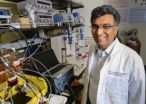(Press-News.org) From hanging up our coats to organizing our bookshelves and kitchen cupboards, some people keep their homes tidy and others seem to live in complete chaos. According to a new study in the Journal of Consumer Research, understanding how we organize our homes can help us cope with contradictions and disruptions occurring in our daily lives.
"Tidying a home is an activity that goes beyond moving objects from one place to another or putting them in specific places. Rather, it is a process of building a meaningful domestic environment. Through their tidying activities, people define symbolic borders and guides that constrain their daily activities and interactions," write authors Delphine Dion (Sorbonne Business School), Ouidade Sabri (Paris-Est University), and Valérie Guillard (University of Paris Dauphine).
To understand how tidiness practices are developed, participants were asked to take photos of both organized and unorganized areas in their homes. While looking at the photos in the lab, the authors asked specific questions in order to find out when that person could or couldn't tolerate a mess.
Results showed that people create tidiness rules using classification systems that help them deal with the objects that keep coming into and moving around their homes. The authors found that while some people use a one-level classification system (all toys go in one box), others use second- and even third-level sub categories (like toys go in their own box, or sets of like toys go in another box).
To cope with disruptions to their classification systems, people react by either modifying the rules or tolerating the transgressions. Being aware of these rules and coping mechanisms can help us better deal with adversity.
"Understanding everyday tidiness practices helps us understand how consumers negotiate social norms regarding tidiness to cope with their daily constraints and opportunities. It enables us to understand the idea of 'home sweet messy home,' that is, how consumers can live in a messy home without feeling any anxiety about it," the authors conclude.
INFORMATION:
Delphine Dion, Ouidade Sabri, and Valérie Guillard. "Home Sweet Messy Home: Managing Symbolic Pollution." Journal of Consumer Research: October 2014. For more information, contact Delphine Dion (dion.iae@univ-paris1.fr) or visit http://ejcr.org/.
Home sweet messy home: How do consumers cope with disorder at home?
2014-06-25
ELSE PRESS RELEASES FROM THIS DATE:
USC scientists create new battery that's cheap, clean, rechargeable… and organic
2014-06-25
Scientists at USC have developed a water-based organic battery that is long lasting, built from cheap, eco-friendly components.
The new battery – which uses no metals or toxic materials – is intended for use in power plants, where it can make the energy grid more resilient and efficient by creating a large-scale means to store energy for use as needed.
"The batteries last for about 5,000 recharge cycles, giving them an estimated 15-year lifespan," said Sri Narayan, professor of chemistry at the USC Dornsife College of Letters, Arts and Sciences and corresponding author ...
Using multiple pictures in an ad? Different perspectives can confuse consumers
2014-06-25
Have you ever wondered what it would be like to see the ocean from a private balcony at a luxury resort? Self-imagery is a powerful marketing tactic and many ads use pictures that help you see yourself using a product or service. According to a new study in the Journal of Consumer Research, showing photos from multiple perspectives can have a negative effect on how a person processes the information in an ad.
"The use of photos showing the advertised product or service from multiple perspectives is very common in ads. However, we show that these multiple perspective ads ...
MM-398 added to standard treatment shows survival benefit in mets pancreatic cancer
2014-06-25
Adding the novel MM-398 to standard treatment for metastatic pancreatic cancer patients who have already received gemcitabine improves survival, researchers said at the ESMO 16th World Congress on Gastrointestinal Cancer in Barcelona.
"Patients with metastatic pancreatic cancer or pancreatic cancer in general have very limited options," said study author Andrea Wang-Gillam, assistant professor in the Division of Oncology at Washington University in St. Louis, USA. "These patients just simply don't do well. This was a positive trial and will provide a new treatment option ...
Curiosity travels through ancient glaciers on Mars
2014-06-25
3,500 million years ago the Martian crater Gale, through which the NASA rover Curiosity is currently traversing, was covered with glaciers, mainly over its central mound. Very cold liquid water also flowed through its rivers and lakes on the lower-lying areas, forming landscapes similar to those which can be found in Iceland or Alaska. This is reflected in an analysis of the images taken by the spacecraft orbiting the red planet.
NASA’s Mars Curiosity Rover has completed a Martian year –687 Earth days– this week. The vehicle travels through an arid and reddish landscape ...
Taking the 'random' out: New approach to medical studies could boost participation
2014-06-25
ANN ARBOR, Mich. — It's a classic Catch-22: Medical researchers need to figure out if a promising new treatment is truly better than a current one, by randomly assigning half of a group of patients to get each treatment.
But when they approach patients about taking part in the study, those 50-50 random odds don't sound good enough – and the study struggles to get enough volunteers. That slows down the effort to improve treatment for that condition.
Now, new research shows the promise of an approach that takes some of the "random" out of the process, while preserving ...
Women having babies later in life more likely to live longer
2014-06-25
CLEVELAND, Ohio (June 25, 2014)—Women who had their children later in life will be happy to learn that a new study suggests an association between older maternal age at birth of the last child and greater odds for surviving to an unusually old age. That's according to a nested case-control study published online today in Menopause, the journal of The North American Menopause Society (NAMS).
In this study which used Long Life Family Study data, 311 women who survived past the oldest fifth percentile of survival (according to birth cohort-matched life tables) were identified ...
Carnegie Mellon method automatically cuts boring parts from long videos
2014-06-25
PITTSBURGH—Smartphones, GoPro cameras and Google Glass are making it easy for anyone to shoot video anywhere. But, they do not make it any easier to watch the tedious videos that can result. Carnegie Mellon University computer scientists, however, have invented a video highlighting technique that can automatically pick out the good parts.
Called LiveLight, this method constantly evaluates action in the video, looking for visual novelty and ignoring repetitive or eventless sequences, to create a summary that enables a viewer to get the gist of what happened. What it produces ...
Aging with HIV and AIDS: A growing social issue
2014-06-25
TORONTO, June 25, 2014–As the first people with HIV grow old, a new study from St. Michael's Hospital questions whether the health care system and other government policies are prepared to meet their complex medical and social needs.
In high-income countries such as Canada, 30 per cent of people living with HIV are 50 or older, and many are living into their 60s and 70s. In San Francisco, more than half the people with HIV are over 50.
"It's a positive thing that people are aging with HIV," said Dr. Sean B. Rourke, a neuropsychologist who heads the Neurobehavioural ...
Advanced light source provides new look at skyrmions
2014-06-25
Skyrmions, subatomic quasiparticles that could play a key role in future spintronic technologies, have been observed for the first time using x-rays. An international collaboration of researchers working at Berkeley Lab's Advanced Light Source (ALS) observed skyrmions in copper selenite (Cu2SeO3) an insulator with multiferroic properties. The results not only hold promise for ultracompact data storage and processing, but may also open up entire new areas of study in the emerging field of quantum topology.
"Using resonant x-ray scattering, we were able to gather unique ...
Reorganization of crop production and trade could save China's water supply
2014-06-25
PRINCETON, N.J.—China's rapid socioeconomic growth continues to tax national water resources – especially in the agricultural sector – due to increasing demands for food. And, because of the country's climate and geography, irrigation is now widespread, burdening rivers and groundwater supplies.
One solution to these growing problems, however, might be to reorganize the country's crop production and trade, especially in agricultural provinces such as Inner Mongolia, Heilongjiang and Hebei, according to new report issued by Princeton University's Woodrow Wilson School ...





